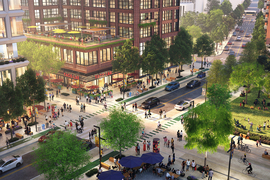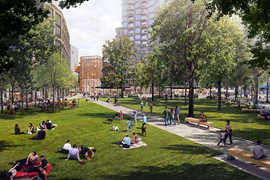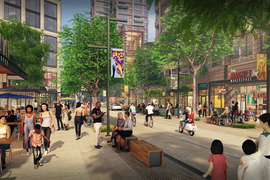MIT’s proposed redevelopment of the 14-acre Volpe parcel in Kendall Square is ready to start a new chapter in its review and approval process. With the Institute’s design and construction of the new John A. Volpe National Transportation Systems Center on four acres of the site underway, the Volpe team is now focusing on the remaining 10 acres of the parcel.
This planned two-step process was anticipated in the Volpe zoning agreement with the city as the federal government required the building of its transportation center in advance of the development of the rest of the site.
MIT’s proposal to transform the Volpe parcel into a dynamic mixed-use development includes approximately 1,400 new residential units, state-of-the-art innovation and research space, a community center, open space, and a concentration of entertainment, retail, and cultural uses that will serve residents, employees, students, and visitors alike.
Today, MIT officials submitted an application to the city for “Article 19” project review and “Planned Unit Development” special permits. This stage of review will take a closer look at the overall site plan, proposed uses, and general infrastructure — essentially a deeper dive into the “look and feel” of the proposal for the parcel. This phase includes comprehensive municipal review and ongoing community-based input, which are key ingredients in creating a successful multiuse project in Cambridge.
Building on a collective body of work
The Volpe project’s arc to-date tells a story of collaborative and creative thinking, stemming from years of examination of Kendall Square’s past, present, and future. MIT has been a longtime partner in the visioning process for Kendall — together with the city and the broader community — beginning with its participation in a 2001 East Cambridge planning study and continuing through multiple analyses of the area’s unique characteristics and needs.
Since 2016, Volpe-specific milestones include the development of community-sourced planning and design principles by the city-established Volpe Working Group, the federal government’s selection of MIT as the developer of the parcel, input from an MIT Volpe Working Group appointed by the Provost, MIT’s filing of a rezoning petition which led to a comprehensive review process with 85 community meetings, the city Council’s approval of the plan, and now the submittal of the project review application for the 10 acres — a plan that is consistent with the zoning.
Two decades of collective planning have helped MIT to understand how the Volpe redevelopment can best serve the interests of all sectors and communities in
Cambridge. At the outset of MIT’s involvement in Kendall Square, President L. Rafael Reif presented a shared vision: “Our future success depends on making sure that Kendall succeeds as a place — a place where people want to live, work and play, and a place that makes our city stronger too.”
In keeping with the carefully developed aspirations for Kendall Square, the Volpe project includes approximately:
- 1.7 million square feet of lab, research, and office space;
- 1,400 residential units, including 280 permanently subsidized affordable units and 20 middle-income units;
- 3.5 acres of publicly beneficial open space (about 35 percent of the site);
- a 20,000 square foot community center; and
- retail and active street uses throughout the project.
The project also provides a range of community benefits including approximately $36 million for affordable housing, $8.5 million for transit improvements, and an $8.5 million nonprofit community fund serving Cambridge residents, as well as the launch of the Job Connector by MIT and $8.5 million to create the Grand Junction Community Path. In addition, once fully built out, the development is expected to generate over $23 million annually in real estate taxes on property that today is tax-exempt. Through the zoning process, MIT also committed to the creation of 950 new graduate student beds.
The most recent project presentation can be found on the Volpe project website.
Sustainability as a central feature
The Volpe redevelopment will be an exemplar of urban sustainability. MIT will design and implement the largest site-wide blackwater system in the Northeast which will reduce water use by at least 50 percent. This significant investment will demonstrate leadership in sustainability both locally and nationwide. Additionally, MIT is committed to eliminating fossil fuels in the Volpe project’s residential buildings. All 1,400 units — including 280 affordable units — will be electric only.
The redevelopment’s commercial buildings will be designed for full electrification and sitewide decarbonization in the future, in concert with Cambridge’s Net-Zero vision. Resiliency is built into the project through the elevation of critical equipment, residential units, and all building ground floors that are above the projected 2070 100-year flood level, as well as other mechanisms that anticipate climate changes.
MIT is voluntarily adopting many local initiatives and green practices that will benefit all stakeholders. The project is now in the master planning stage, and MIT will explore further sustainability measures related to efficiency, healthy buildings, and engineering systems as it moves forward with individual building design.
Balancing the input of multiple stakeholders
Because the Volpe parcel is ideally situated in a shared business and residential district, and because MIT has chosen a path of maximum collaboration, many different — and sometimes conflicting — values related to urban planning are brought forward through the review process. Building orientation, open space layouts and uses, the nature of retail and active spaces, desire lines for pedestrian connections, and the configuration of the community center are subjects that naturally elicit differing perspectives.
In anticipation of multiple views on these and other topics, MIT held a series of workshops during the zoning process to determine the community’s preferred choices related to the planning of the site. Ultimately, those preferences were incorporated in the zoning petition and are integral to the special permit proposal, which will now be reviewed by the Cambridge Planning Board.
MIT Provost Martin Schmidt says: “In watching the zoning process, I was happy to see such commitment and thoughtfulness on the part of the broader community. People brought their firsthand experiences and current circumstances to the table — as well they should — and the mixing of ideas and priorities resulted in robust discussion about what is best for the common good.”
One such area of discussion has been the location of the project’s open space, which MIT originally proposed for the middle of the site. As a result of feedback received through the community meetings and workshops, four scenarios were ultimately developed with the open space sited at the corner of Third Street and Broadway. MIT considered these variations with input from the whole community and selected a site plan with the open space at that corner, and with the site’s less intensive housing and community center uses (rather than commercial uses) adjacent to the existing neighborhood residential building.
With the launch of the special permit process, MIT will continue to consider these types of urban planning complexities with an approach marked by fairness and openness. The Volpe team introduced the special permit phase by hosting general community-wide sessions on the project, followed by individual meetings with specific groups and constituencies. The community-focused listening and learning process will continue through the Planning Board’s public hearings.
The Volpe parcel, currently underutilized and inaccessible, will contribute to Kendall Square in ways that no other site can. Because of its size, MIT can develop a true mixed-use environment, at once creating a vibrant new residential community and further propelling the bustling innovation enterprise.
“To this day, I’m not aware of another location that has all the ingredients that Kendall Square embodies,” says Schmidt. “With our live-work-learn-play approach in Kendall, we are uniquely and fully positioned to advance science and technology here — and obviously, the world needs that now more than ever.”
Michael Owu, managing director at MIT’s Investment Management Company, oversees the Volpe project and has been involved in the community’s Kendall Square and East Cambridge urban planning processes since the beginning. “What we’re trying to do here,” Owu notes, ”is create a pleasing, vibrant, and compelling mixed-use district for residents, employees, and visitors that builds on Kendall Square’s success and complements the vital neighborhoods nearby.”
Creating an equitable and inclusive development
While MIT has focused on building community consensus around the Volpe plan’s components and details for several years, another theme has emerged as critically important to the success of the development.
“We want to create an environment where all people feel welcome and included — a place where everyone feels that they belong,” says Sarah Gallop, MIT’s co-director of government and community relations. “We have no interest in paying lip service to this ideal, so we decided to take on the hard work of really finding out what needs to be considered and implemented.”
In December 2020, MIT launched a series of seven workshops to gather general community input and to discuss how best to create an equitable and inclusive Volpe development. The first workshop focused on the community center and what kinds of programs, operations, and principles would foster inclusivity and serve to celebrate Cambridge’s diverse community. More than 80 people attended and a video capturing the discussion highlights was sent to all participants. The second workshop focused on the needs and aspirations of youth between the ages of 17 and 23. Approximately 40 participants shared insightful ideas about the programming and functions of the community center.
Future workshops will continue to collect overall feedback and focus on collaborating with other nearby community-based centers, as well as exploring what kinds of retail and active uses will promote equity, how the housing can be designed, built and operated in an inclusive manner, what kinds of jobs will be needed and how the Job Connector by MIT can assist residents with employment, and how the open space can be programmed so as to maximize inclusiveness and participation.
Going forward
The city will review MIT’s Volpe special permit applications and schedule an initial public hearing with the Cambridge Planning Board. The architects, urban planners, and individuals in related professions who make up the Planning Board will review all aspects of the proposal and provide input that will further shape the development.
More information can be found at the Volpe Redevelopment Project website.

















